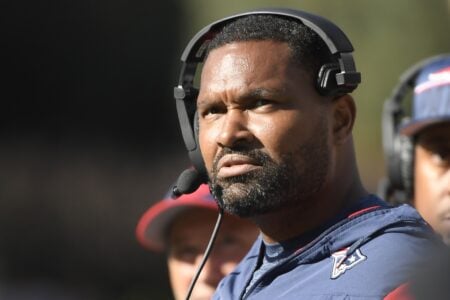shirtsleeve
In the Starting Line-Up
- Joined
- Nov 20, 2005
- Messages
- 2,598
- Reaction score
- 0
There's always ways to dial up pressure- it's one of the most scheme diverse concepts out there. It depends on what kind of overall personnel you want, what kind of sub-d you want, what kind of sub-d personnel you are going to run, what type of defensive philosophy you are going to have, what kind of safety and corner depth you have, the list goes on forever.
In terms of the Patriots I think that most of everything that can be said already has been. Especially true with Andy's point about the value of a guy who can 2-gap the run and get after it from the 2-gap techniques. It is also important to say how much experience comes into play with schematic diversity. Part of being a great "pass rush" team comes from veteran understanding of option blitzes, coverage checks, and a defender's pass rush moves. Before I get into how to draw it up, or what options are available, let's have a look at what a very simple man v man pass rush is.
Most defenders can be lumped into three categories when it comes to rushing the passer; speed, speed to power, or power. I think that the names are mostly self-explanatory, but there are some nuances in the game. Most speed guys are reliant upon their acceleration through three steps to blow by blockers. Most sacks or hits you'll see them get are either clean blindsides or with a tackle hanging off of their inside shoulder as they collide with the QB. The latter is the product of the favorite move of the speed guy- the rip. Speed guys will often take pretty substantive outside techniques. Invisible 6 or 7 techniques for example. This will force the tackle to get depth quickly to compensate for the distance. Speed guys are usually easily negated with chips from TE's, slot guys, and backs. Their typical counter move is a spin (see Freeny, Dwight), or if they are really tall they will swim across an over extended blocker. Speed rushers work on latitude. Power rushers take advantage of leverage and hand technique. They control the extension battle, typically occupy the low ground, and take advantage of players driving against their bullrush. They will often setup a clean break with repeated bullrushes. Once the offensive player becomes over extended towards contact, the defender will grab their jersey and use the momentum of the offensive player throw them away. This is highly effective because it actually boosts the defenders acceleration as they throw and slip past the blocker. Think of it as rowing a canoe paddle. Power rushers operate on longitude. Speed to power guys are your mid-size 43 ends, large 34 OLB's, and in some cases 3-techniques. Warren Sapp is a really good example of a guy who was a DT who had a speed to power game. For a while he made the 4i a legit NFL alignment. They have great burst to compliment great trunk power and a savvy understanding of how both set eachother up. Off ball engagement is all about balance and leverage. Speed extends, power removes balance and leverage. If a player is extended, they have no leverage, if they are driving against a bullrush, it is easy to pull them off balance by their jersey or swim them. A player getting depth against a speed move is highly vulnerable to a strike to the breastplate and a bullrush. These are the most dangerous rushers as they operate in three dimensions.
The best Patriot pass rushers were speed to power guys. They still have guys like this (Cunningham, Ninko, Mayo, Spikes, Pryor), and I believe that 75 is still quite capable of being a dominant 1-technique. I don't think that they have the schematic flexability yet to dial up the blitz packages, so the onus needs to be on the sub-d. They need to find ways to eliminate the sub-run from 1-gap techniques within the nickel. This will enable them to generate a better pass rush off of the defensive line utilizing twists, loops, and stunts. Once the young guys get more experience within the scheme, they will be able to dial up some more backer and secondary blitzes from their base 34 in addition to their 33 or 24 nickel. The best answer I can give is to generate rush in sub from the 42 nickel once they fix the weak zone and other sub runs. Once the younger players get more reps and experience, dial up the true design of the 34 and use confusion in both pressure and coverage to generate pressure.
Can we take a picture of this post and sticky the entire text across the top of the page, please?



















